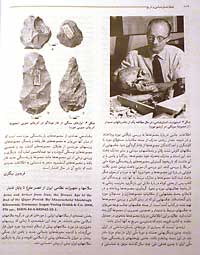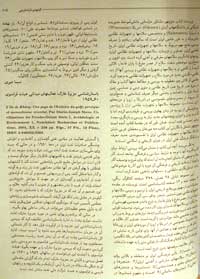PUBLICITY | Ms. Sima Miri, Senior Museum Specialist and Analyst of the Luristan and Historical Departments National Museum of Iran
February 2008, Book Review: Arms and Armor from Iran
 The western scholars have placed a large part of Iranian weapons in the category of Islamic weapons. Although this classification had been accepted to some extent before more detailed analyses of pre-Islamic weapons were done, the discovery of new archaeological sites and ancient weapons have added to our knowledge of pre-Islamic Iran and show the necessity to review and reclassify the Iranian weapons. The author of the book “Arms and Armor from Iran,“ Manouchehr Moshtagh Khorasani is a graduate of business administration [and English and Spanish] from the German university (Giessen), American University (Wisconsin), and Spanish university (Salamanca), and is an expert in the Middle Eastern weapons especially the Iranian arms and armor. He spent years in doing research on different important sources on arms and
The western scholars have placed a large part of Iranian weapons in the category of Islamic weapons. Although this classification had been accepted to some extent before more detailed analyses of pre-Islamic weapons were done, the discovery of new archaeological sites and ancient weapons have added to our knowledge of pre-Islamic Iran and show the necessity to review and reclassify the Iranian weapons. The author of the book “Arms and Armor from Iran,“ Manouchehr Moshtagh Khorasani is a graduate of business administration [and English and Spanish] from the German university (Giessen), American University (Wisconsin), and Spanish university (Salamanca), and is an expert in the Middle Eastern weapons especially the Iranian arms and armor. He spent years in doing research on different important sources on arms and  armor, Iranian military history, decoration on Iranian arms and armor, and casting methods for bronze and iron weapons. In addition to collecting many types of weapons from the bronze age to the end of the Qajar period, Manouchehr Moshtagh Khorasani provides a new insight on arms and armor and the military point of view. Parts of his research deals with several books and articles dealing with art, art history, military history, religious and epic texts, such as the Avesta, the Qur’an, the Shahname. Another part of his research presents a collection of artifacts from private collections in Euorope, USA, and Iranian museums. The collections of Iranian arms and armor [from Iranian military museums] was already analyzed by Professor Romanowsky from Russia in the Pahlavi period. However, with the course of time and new research, there was a necessity to do research on these items again. As it is mentioned in the introduction, by publishing this book Manouchehr Moshtagh “has shown the western historians and scholars that the new classification and analysis of arms and armor from Iran represents the rich culture of Iran in historical and Islamic periods.“ What distinguishes this book is showing the relationship between the artifacts and their usage based on the political and cultural background of the society. The interesting work done by Moshtagh Khorasani includes the explainations of the historical and cultural relationship of these periods by taking royal and religeous symbols into consideration. The book has 28 chapters, 378 pages of colored catalog, 9 pages of index, and 14 pages of references. The author provides an important overview of the most important events in the Iranian history and then describes different kinds of arms and armor such as swords, daggers, knives, shields, maces, axes, helmets, and bows and arrows from the bronze age to the end of the Qajar period. He also provides a list of weapon makers who wrote their names on some artifacts. He also explains the symbol of the lion and the sun, the lion and the bull, the dragon, tools used in the varzesh pahlavani, and the principles of javanmardi. The pictures of artifacts are taken from some Euoropean and American private collections, Iranian museums, and the Zurkhane of Astan Qods Razawi. The majority of these pictures are shown for the first time. A group consisting of 17 experts from the USA, UK, New Zealand, Australia, Canada, and Hong Kong were responsible for editing the book. The chapters include 1. Introduction 2. The Iranian cultural influence in the region and the Iranian search for independence 3. Bronze and iron weapons from Iran, 4. Median and Achaemenian daggers and swords, 5. Parthian swords and daggers, 6. Sassanian swords, 7. The importance and meaning of the sword in Iran after the Muslim conquest, 8. Shamshir (sword) and its varieties, 9. The mystery behind dhufaghar “zolfaghar”, the bifurcated sword of Ali, 10. Iranian straight swords: the re-emergence or coexistence with curved swords, 11. Iranian military swords from the Qajar period (shamshir nezami),12. Qame and qaddare (double-edged short sword and one-edged short sword), 13. Khanjar (double-edged dagger), 14. Kard (one-edged knife), 15. Pishqabz (double-curved, one-edged dagger), 16. Neyze and zubin (spear and javelin), 17. Gorz (mace), 18. Tabar / Tabarzin (axe and saddleaxe), 19. Separ (shield), 20. Zereh and joshan (armor), 21. Tir va Kaman (bow and arrows), 22. The meaning of the emblem of the lion, the sun, and the lion fighting a bull on pieces of arms and armor, 23. The Iranian warrior tradition: Iranian treatises on warfare and martial arts, 24. Koshti (wrestling), other martial practices, and their role in preparing the warriors for the battlefield, 25. Dervishes, 26 Naggali (traditional reciting of Shahname) ,27. Arms and armor used in taziye (Shiite passion play), 28. Conclusion, and 29. Catalog
armor, Iranian military history, decoration on Iranian arms and armor, and casting methods for bronze and iron weapons. In addition to collecting many types of weapons from the bronze age to the end of the Qajar period, Manouchehr Moshtagh Khorasani provides a new insight on arms and armor and the military point of view. Parts of his research deals with several books and articles dealing with art, art history, military history, religious and epic texts, such as the Avesta, the Qur’an, the Shahname. Another part of his research presents a collection of artifacts from private collections in Euorope, USA, and Iranian museums. The collections of Iranian arms and armor [from Iranian military museums] was already analyzed by Professor Romanowsky from Russia in the Pahlavi period. However, with the course of time and new research, there was a necessity to do research on these items again. As it is mentioned in the introduction, by publishing this book Manouchehr Moshtagh “has shown the western historians and scholars that the new classification and analysis of arms and armor from Iran represents the rich culture of Iran in historical and Islamic periods.“ What distinguishes this book is showing the relationship between the artifacts and their usage based on the political and cultural background of the society. The interesting work done by Moshtagh Khorasani includes the explainations of the historical and cultural relationship of these periods by taking royal and religeous symbols into consideration. The book has 28 chapters, 378 pages of colored catalog, 9 pages of index, and 14 pages of references. The author provides an important overview of the most important events in the Iranian history and then describes different kinds of arms and armor such as swords, daggers, knives, shields, maces, axes, helmets, and bows and arrows from the bronze age to the end of the Qajar period. He also provides a list of weapon makers who wrote their names on some artifacts. He also explains the symbol of the lion and the sun, the lion and the bull, the dragon, tools used in the varzesh pahlavani, and the principles of javanmardi. The pictures of artifacts are taken from some Euoropean and American private collections, Iranian museums, and the Zurkhane of Astan Qods Razawi. The majority of these pictures are shown for the first time. A group consisting of 17 experts from the USA, UK, New Zealand, Australia, Canada, and Hong Kong were responsible for editing the book. The chapters include 1. Introduction 2. The Iranian cultural influence in the region and the Iranian search for independence 3. Bronze and iron weapons from Iran, 4. Median and Achaemenian daggers and swords, 5. Parthian swords and daggers, 6. Sassanian swords, 7. The importance and meaning of the sword in Iran after the Muslim conquest, 8. Shamshir (sword) and its varieties, 9. The mystery behind dhufaghar “zolfaghar”, the bifurcated sword of Ali, 10. Iranian straight swords: the re-emergence or coexistence with curved swords, 11. Iranian military swords from the Qajar period (shamshir nezami),12. Qame and qaddare (double-edged short sword and one-edged short sword), 13. Khanjar (double-edged dagger), 14. Kard (one-edged knife), 15. Pishqabz (double-curved, one-edged dagger), 16. Neyze and zubin (spear and javelin), 17. Gorz (mace), 18. Tabar / Tabarzin (axe and saddleaxe), 19. Separ (shield), 20. Zereh and joshan (armor), 21. Tir va Kaman (bow and arrows), 22. The meaning of the emblem of the lion, the sun, and the lion fighting a bull on pieces of arms and armor, 23. The Iranian warrior tradition: Iranian treatises on warfare and martial arts, 24. Koshti (wrestling), other martial practices, and their role in preparing the warriors for the battlefield, 25. Dervishes, 26 Naggali (traditional reciting of Shahname) ,27. Arms and armor used in taziye (Shiite passion play), 28. Conclusion, and 29. Catalog
 Top
Top









